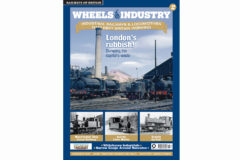The Express Dairy Motorised Fleet
Posted by Chris Graham on 27th May 2020
Allan Bedford looks at the history of the Express Dairy Motorised Fleet between 1920 and 1955, with a selection of interesting period photographs.
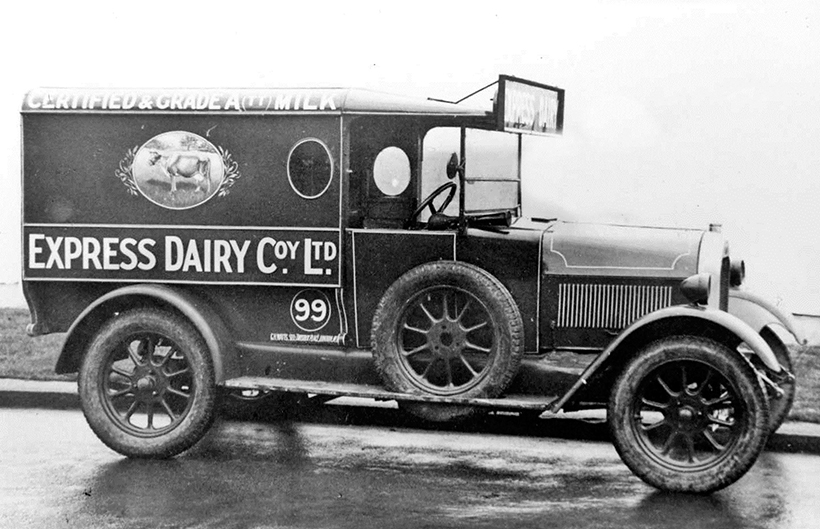
The Express Dairy Motorised Fleet: This Morris Cowley was purchased by the Express as a 10cwt van and milk float. A classic ‘squashed’ Bullnose on chassis no 169743, fleet no 99, RP 3530, it was first registered in Northampton, in 1926, but was purchased second-hand from Freeman & Fisher of Eltham High Street in April 1929. No record of maintenance costs exist for this one, but it passed to the Ranburn Magneto Company in Greenwich in June 1932 for £5; the name of Ranburn still trades in the area.
The Museum of English Rural Life in Reading (MERL), has a considerable archive relating to the activities of the Express Dairy Company. This includes several volumes of ‘transport history books’, which contain details of all steam-, petrol- and diesel-powered vehicles, including company cars purchased or acquired with other businesses.
These handwritten ledgers – with a page for each fleet number – cover the period 1920-1955. Unfortunately, I’ve not been able to trace through the museum if later ledgers still exist. Clearly this method of recording was continued beyond 1955, as disposal details stretching to 1962 have been seen. Separate ledgers also exist for electric floats and ‘prams’, but I haven’t studied or included this aspect, but the records are there for others to inspect.
Each ledger page contains details of purchase and registration date, bodywork and, in most cases, chassis and engine numbers, together with registration number initial cost, supplier and often disposal date and price fetched. The ledgers before 1950 also contain detailed costings for all mechanical and body overhaul, painting, as well as dates of all such work.
The company fleet numbers are somewhat confusing, with company cars and small vans all given a number. When Express Dairy celebrated its centenary in 1964, the company published a book ‘Express Journey’. The chairman at the time, the long-serving Walter Nell, wrote in the book’s forward about the importance of preserving relevant company archives, and no doubt, thanks to him, some of these records survive, and with it his part in the company’s wonderful transport history.
Important dates in the company’s first 50 years – 1864-1914 – taken from the book Express Journey
1864
Founder, George Barham – a dairyman since 1858 – supplements his supply of London milk with the sourcing of additional milk from the countryside around London. He brought it to the capital via the developing railway network, to be sold and distributed by his new business ‘The Express Country Milk Supply Company’.
1865/66
Most indigenous London cattle herds unfit due to severe infection, George Barham looks further afield to Derbyshire and Leicestershire to replace the contaminated supply. He becomes a wholesale supplier of milk, with the first conical churns being developed for transport.
1882
The Express become a limited company.
1883
The 200-acre College Farm in Finchley becomes both a showcase for livestock and equipment, and a supplier of fresh ‘London’ milk.
1884
Early development of bottled milk.
1900
The company now boasts 24 teashops/cafés, 10 branch dairies and seven shops.
1913/14
The founder, Sir George Barham, dies and is succeeded by his son, Titus.
Company progress, 1920-1955
With the death of the founder in 1913, Sir George Barham’s eldest son, Titus, gained control of the commercial side of the business, with his brother, Arthur, taking over the dairy supply company. This handled the wholesale supply of milk, and the sale of equipment to the dairy industry. They each held a 50% holding in the other’s company.
In 1917, the dairy supply company merged with the other two largest wholesalers in London – the Great Western & Metropolitan and the Wiltshire United – to form ‘United Dairies’ and, thus, two giants of the industry were controlled by one, far-from-united family.
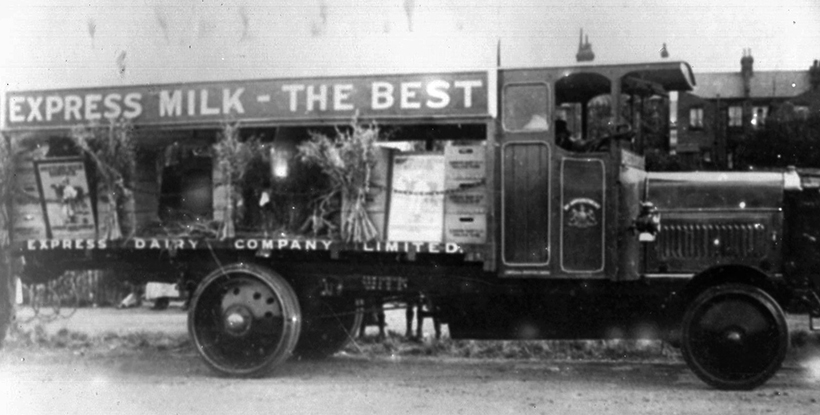
A well-built chain-sided float body fitted with a substantial cab feature on this three-ton ‘RAF’ Leyland, dating from around the time that Walter Nell was appointed engineer and transport manager. The vehicle appears to have been decorated for a parade.
Walter Nell, a great nephew of the founder, who’d begun an engineering apprenticeship at the age of 15 (subsidised by his great uncle), was seeking a position in 1919, after completing his war service where he rose to the rank of captain. Both brothers offered him a senior position in their opposing camps. Despite the offer from the Express reputedly being half that of the United, Titus Barham won his services, and he was appointed the company’s Engineer and Transport Manager, at the age of 25.
His first task was to re-organise the company’s fleet of nondescript motors and worn out plant and machinery. Leyland Motors was soon contacted, and a new fleet began to take shape. Two five-ton Leylands were based at College Farm in 1923, and were engaged in collecting the conical churns of milk from the London railway termini, for delivery to pasteurising centres. They carried 40 churns plus a further 20 on a trailer. The Sentinel steam waggons also in service at the time, when coupled to a trailer, could manage an extra five.

First seen at the Commercial Motor Show held at Olympia in 1925, Super Sentinel six-tonner no 6029 became Express fleet no 3, YL 29. During its seven-year stay, the recorded expenditure on renovations and repainting amounted to £48, with an engine and chassis overhaul on the second major ‘docking’ in March 1932, recorded at £23 3s 8d. It was traded into Leyland Motors eight months later, realising £30, and it would appear from surviving records that it enjoyed quite a long second life in the Liverpool area.
At this time, the vehicles were serviced by a team of fitters travelling to the distribution depots in a Ford Model T. By the early 1930s, major overhauls were undertaken at the large Cricklewood bottling depot, when it was claimed: ‘chassis are completely stripped every 14 months and bodies made on the premises.’ The coachbuilding firm of TH Lewis of Camden Town – which had supplied many of the company’s carts and vans – was, by 1931, part of the ‘Express family’.
By the mid-1920s, the company had installed an American bottling plant at College Farm and in other branches across London. A massive site owned by the LMS railway, in Cricklewood, north-west London, was leased by Express, and a state-of-the-art dairy and distribution plant built. This enabled railway tank wagons to arrive in on one side, and for bottled milk to leave on the exit road opposite. The facility was operational by 1929.
This also allowed the company to establish new regional hubs in the north, with direct rail links to Cricklewood. These included Appleby (1931), Rowsley in the Derbyshire Peak District (1933) and Leyburn, North Yorkshire (1937). To the west, ‘The West Park Dairy in Frome’ was purchased in 1935, and a new depot built at Seaton Junction, on the Southern Railway, which later developed into an important centre for egg collection with bulk supplies leaving for the capital.
Another bottling plant opened in Acton in 1934. The Harrow Road depot became the hub for supplies of cream and, in 1931, led to the development – with J&E Hall at Dartford – of the first refrigerated van. This was built on a Morris-Commercial chassis, and entered service to convey this luxury product. This was followed by Gilford and Fordson refrigerated vans.

A fabulous, original photograph of the first refrigerated van built for the Express, by J&E Hall of Dartford, on a Morris-Commercial ‘TX’ 30/40cwt chassis, no 27539. Becoming fleet no 68, GO 9043, the chassis cost £284 4s, and the specialised bodywork and painting added a further £488. Entering the fleet in March 1931, the body was removed in May 1935, being replaced by a simpler affair costing £98. Total ‘docking’ costs between 1932 and 1938 amounted to £477. When sold in March 1940, to a buyer in Archway Road, N6, it realised just £5.
With the death of Titus Barham in 1937, the United Group tried very hard to buy-out their adversary. But all approaches were rebuffed, and Walter Nell was appointed chairman of Express. With the outbreak of World War II, doorstop supplies of milk by competing dairies were restricted, with urban areas ‘zoned’ into reserved territories in the most logical way, dependant on the nearest outlet. However, the Co-op was not restricted in this way. In London alone, 40 of the Express distributing dairies were affected by bomb damage, along with over 40 of the company’s restaurants.
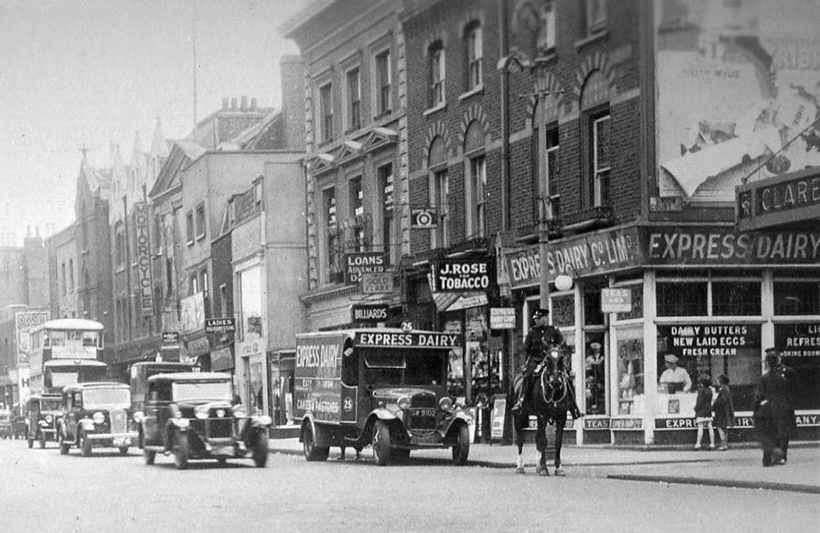
A detail from a wonderful, commercial postcard view of Hammersmith Road, from around 1936. The shop assistant in the Express on the corner can be seen in her ‘whites and mop cap’, while two school girls peered into the window. They were probably pupils from the Sacred Heart High School across the road, which still survives. New laid eggs and cream are advertised while the delivery driver (spot his legs through the chassis!) sorted his load. This Ford ‘AA’ 30cwt box van, Express fleet no 25, GW 9102, was supplied on 8/12/31 by AE Gould Ltd, for £165 8 6d. TH Lewis built the body, which came complete with roller shutters front and rear and cake trays, for £155 19s. Chassis no AA4793085 was built at the new Dagenham plant during the first month of production there. The first vehicle off the line on 1/10/31 was an ‘AA’ truck, on chassis no AA4791110. The van was sold to G Ridler of London W11, in December, 1942, for £27 10s. Apart from the mounted policeman, passing traffic includes a large Sunbeam, an Austin 16/18hp and Morris Oxford.
One of the last incidents of the war involved the Blackheath branch, in South-east London. This historic branch was the first distribution dairy; it had opened in Montpelier Vale, in 1882. Sadly, along with the village centre, it was devastated by a V2 at 12.06pm on Wednesday, March 8th, 1945, resulting in five deaths and 134 injuries.
Further new bottling plants around London were planned when peace returned, including South Morden, which opened in 1955. This could handle one million bottles a day, equalling 120,000 gallons. Both the ‘United’ and ‘Express’ had, by this time, large chains of grocery shops, some adjacent to the local depots. In June 1949, the branch at Hendon central became the first Express Self-Service Store, one year ahead of Sainsbury’s refurbished Croydon store. With post-war recovery in full swing by the early 1950s, and the London suburbs continuing to grow, the company invested in a few self-service shops built on Bedford chassis, as a temporary stop-gap before a permanent outlet could be opened.
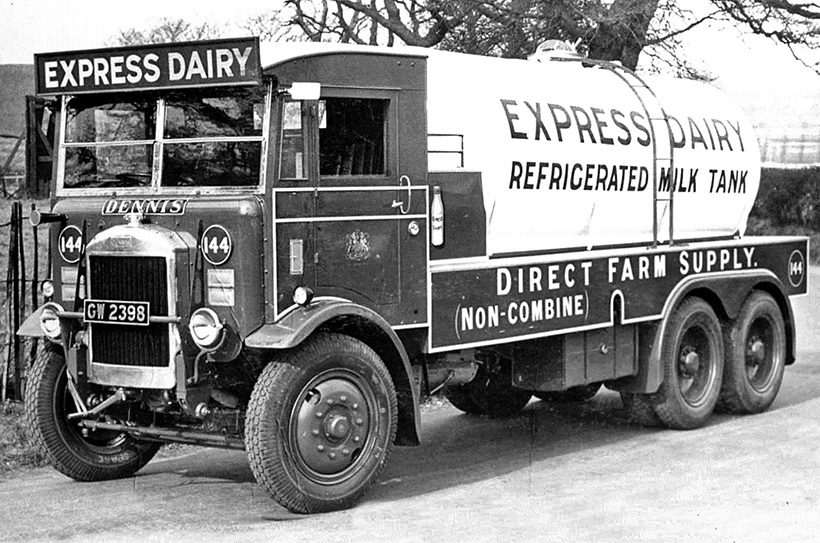
One of a pair of 45hp Dennis tankers, fleet no 144, chassis no 120025 was registered in February 1932, GW 2398, with a ULW of 9.9.2, the tank holding 1,630 gallons. The biggest ‘docking’ expenditure occurred at just 17 months, in September 1933, with a figure of £486 being recorded. The vehicle gave 11 year’s service, before sale to A Wadsworth of Sandy Lane, Leighton Buzzard, in November 1943, for £110 with spares, including axle and radiator.
The company went on to convert and build larger stores and, by 1955, these traded as Premier Supermarkets. By the end of the decade, the company had 20 Premier Supermarkets, as well as the existing self-service stores and was, by this time, ranked as the second largest supermarket operator in Britain.
In Express Dairy’s centenary year – 1964 – the supermarket business was sold to Unilever’s ‘MacFisheries’ chain, and many later traded as Mac Markets, before they too were sold to International, which in turn… But that’s another story!
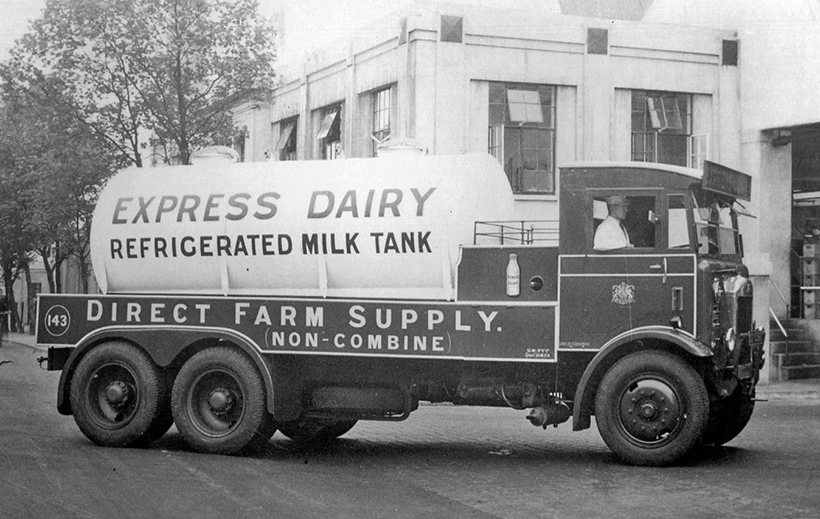
The second of the 1932 Dennis tankers, on chassis no 120026, fleet no 143, GW 9363, was converted into a box van in December 1937, at a cost of £310. It left the fleet a year earlier than its twin, passing to W Smyth of London, N4, for £160, in August, 1942.
Bibliography and thanks
Express Journey – The Centenary History of the Express Dairy Co. Ltd – Bryan Morgan, 1964
Tradition to Technology – The Dairy Industry in Devon – Peter Sainsbury, 1991
An Album of Sentinel Works Photographs Nos 1 & 2 – AR & JL Thomas, 1992/2010
Ford at Dagenham – David Burgess-Wise, 2007
The AEC Story from Regent to Monarch – Brian Thackray, 2012
AEC Trucks in Camera – SW Stevens-Stratten,1984
With special thanks to Phil Moth (PM Photography) for his always cheerful help and selection of period images, David Hambleton – The Trojan Trust (TT), British Commercial Vehicle Museum (BCVM), Commercial Motor Archives, Seaton Museum, Robert Crawley – the WHOTT Archives, Bob Cook, Dave Fane, Dave Godley, Tim Gosling, Dave Lockard (USA) – The Number One Packard Truck Guy!, Barry Lucking, Bob Moorman, William Pierce (DLM 480), John Shearman, The staff of the Museum of English Rural Life, Reading (MERL), The staff of the Kent History and Library Centre, Maidstone, plus many thanks to all the unknown photographers who have made this brief history possible.

This magnificent, AEC Mammoth Major, chassis no 668173, was new in March 1933, as fleet no 126, AGX 855. The tank was built by Hopkins and the streamlined cab by Butterfields, at a total cost of £2,579. The valancing on the tank added approximately 3cwt to the total ULW of 7.2.5. Whether this remained intact during its 13-year service life is doubtful. The vehicle appears to have retained its petrol engine to the end and, on its last thorough overhaul in June 1943, a total of £825 was spent. Passing to T&F Motors in July 1946, it realised £600.
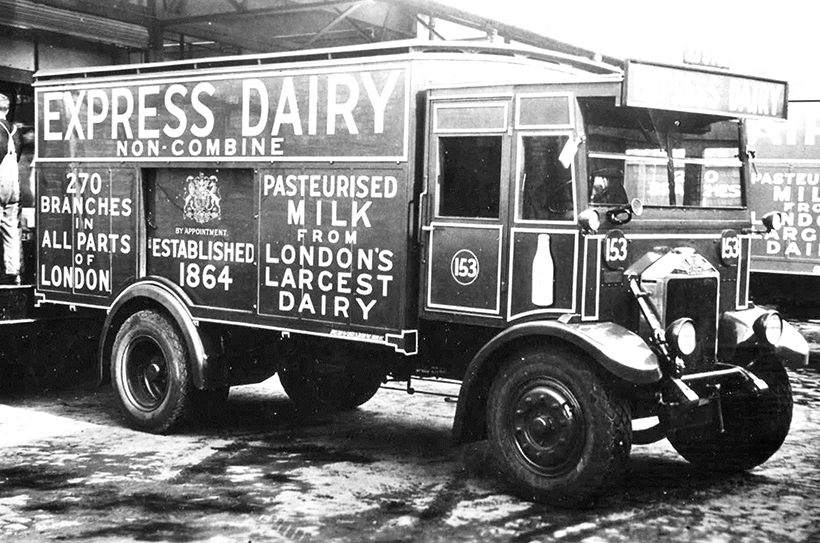
With their low weight, a few Albions joined the fleet during the 1930s. This ‘LK’ 51 overtype, chassis no 17501D, fleet no 153, was registered on 1/3/33, as JJ 9762, with a ULW of 4.15.1.6. Its last overhaul, in August 1943, is recorded at a cost of £242, with the vehicle passing to T&F Motors in August, 1946, for £150.
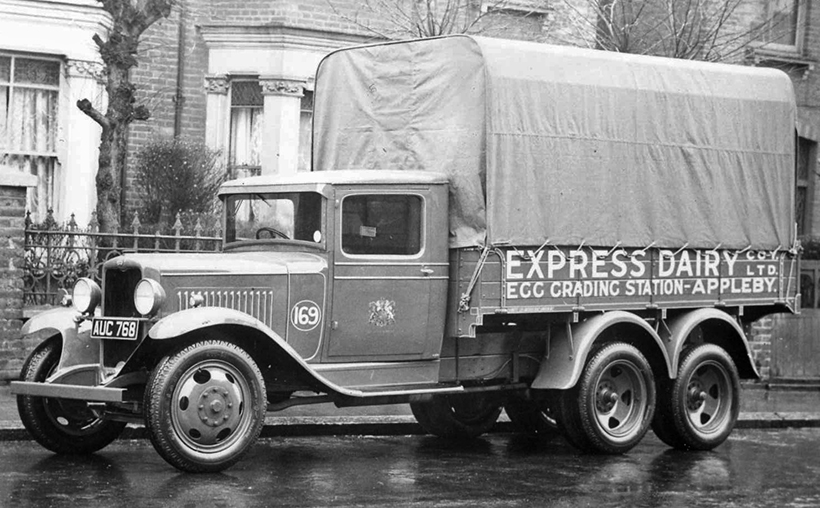
Probably posed in London before its long journey north, this Bedford ‘WLG’, fleet no 169, AUC 768, chassis no 125773, was converted to a six-wheeler by Universal Power Drives. The total cost new, including ‘in-house’ bodywork, came to £383. With a ULW of 2.9.3.17, giving a four-ton ‘useful load’, one wonders how many crates of eggs that would amount to! The front tyres were stated as 600×20, with 30x50s on the rear. A final overhaul in September, 1940, costing £172, extended its life until January 1944. It passed to Dunnings of Enfield for scrap, under MOWT (Ministry of War Transport) licence no 44028, for £35.
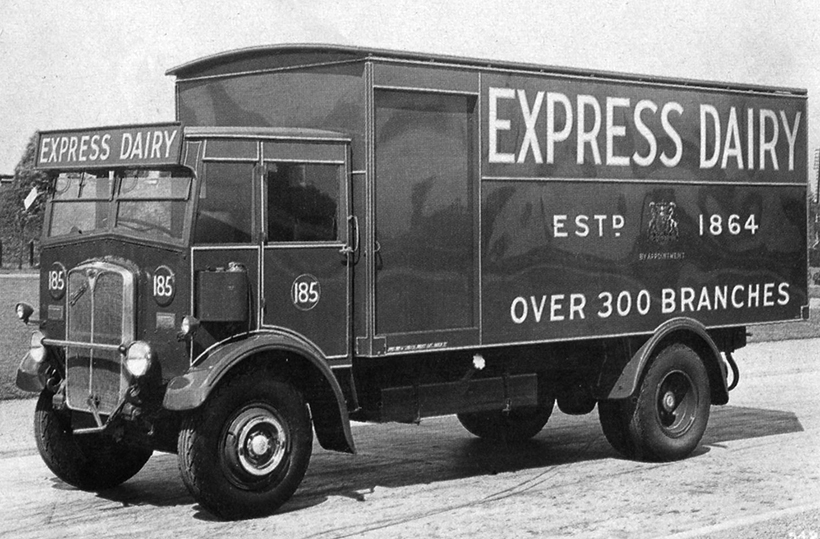
AEC Monarch box van, fitted with a four-cylinder, 80hp petrol-type AE163, chassis no 637073, fleet no 185, was registered on 27/7/34, BGO 490, at a total cost – including the in-house body – of £890. With a ULW of under five tons, a five-ton load could be carried. The last ‘rota overhaul’ in December 1943 cost £208, enabling this ‘veteran’ to soldier-on until September 1946, when it passed to the legendary Birds of Stratford, for £50.
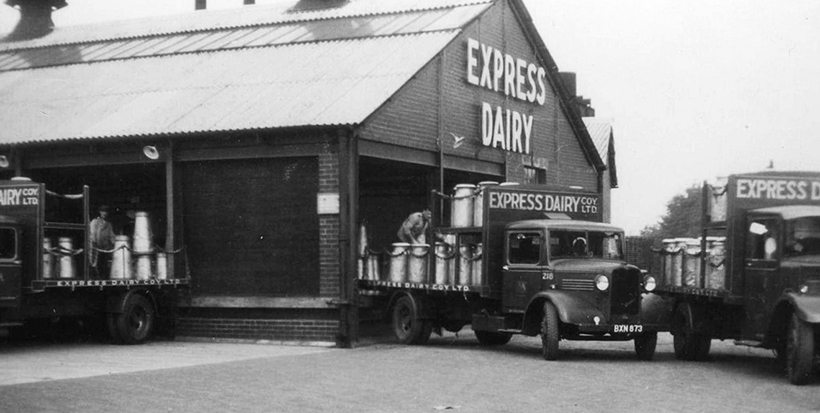
Taken at the Appleby Creamery in June 1936, this image shows two Bedfords in company with a Leyland Cub. The Bedford WTL, fleet no 218, BXN 873, chassis no 874533, was supplied by Spurlings, and registered in April 1935. The cost, including the ‘in-house’ body, amounted to £300. On its final visit to the workshop in June 1943, chassis and body overhaul costs totalled £459. Remaining in the north, MOWT instructions to scrap the vehicle led to a visit to F Adams in Northallerton, on 26/6/45, with £35 changing hands.
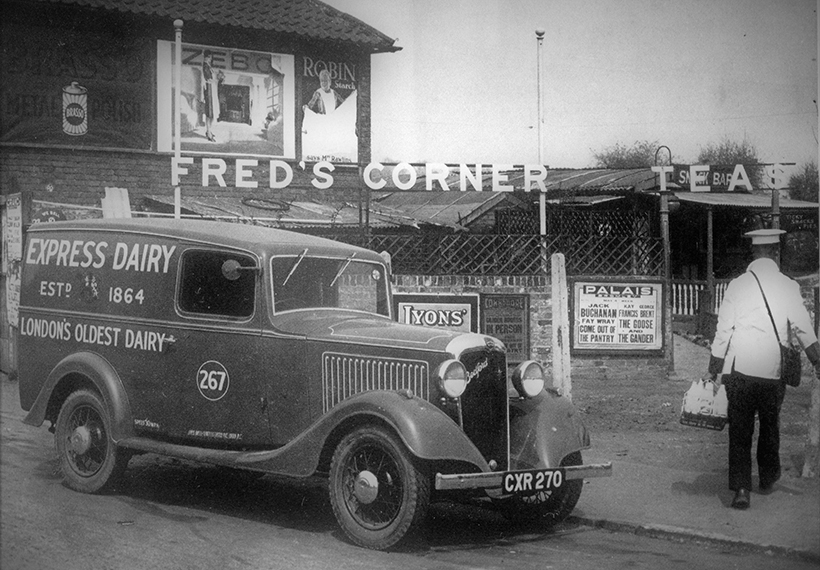
Introduced in mid-1933, the Bedford, six-cylinder, 8cwt van could be bought as a 12hp (ASYC) or a 14hp (ASXC). This one-off for the Express was supplied by Spurlings, at a net cost of £132 17s 6d, and registered on 17/4/36. Seen delivering to Fred’s Café, somewhere in the Bromley area, the local Palais is advertising the British musical film Come out of the pantry, coupled with the American ‘romcom’, The Goose and Gander; both made in 1935. After a mechanical overhaul in January 1939, it was sold three months later.
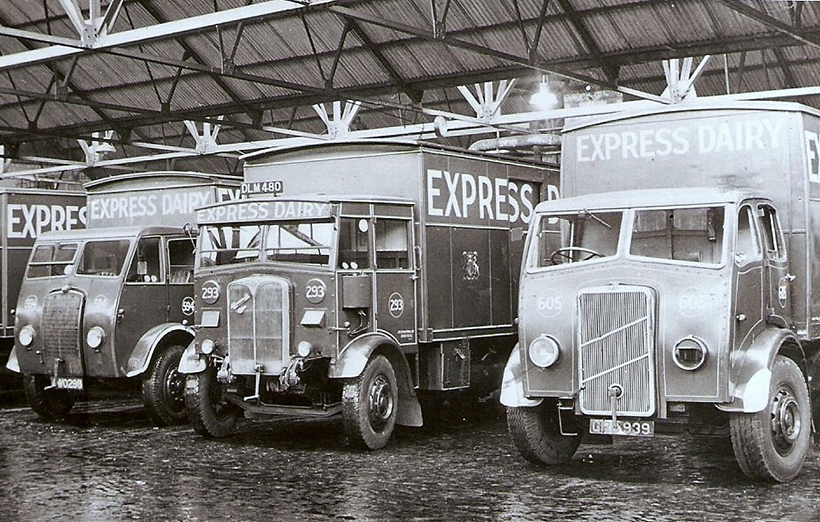
A scene at the Cricklewood bottling depot around late 1945 with, on the left, fleet no 594, AWO 298, a 12-ton Foden ‘DG’, first registered in Monmouth in April 1936, on chassis no 17024. It was purchased by the dairy in July 1943, from Fodens at Sandbach, for £1,751, with the box body being fitted at the end of the year at a further cost of £352. It passed to Birds at Stratford in March 1947, for £650. On the right, the ERF fleet no 605, GRB 939, on chassis no 2230, was first registered in Derby in August 1940. It was obtained from Murphy Bros of Leicester in August 1943, for £3,200, then received a new box body in December 1943, costing £378. Disposal followed in July 1947, again to Birds for £1,000. In the centre was perhaps a lone survivor of the many AECs to join the Express. This Mammoth Major, fleet no 293, chassis no 366099, DLM 480, was first registered in December 1936. At the time of its purchase, two Sentinel steamers, waggon nos 1581/82, fleet nos 37 & 38, were taken in part-exchange, at £20 each.
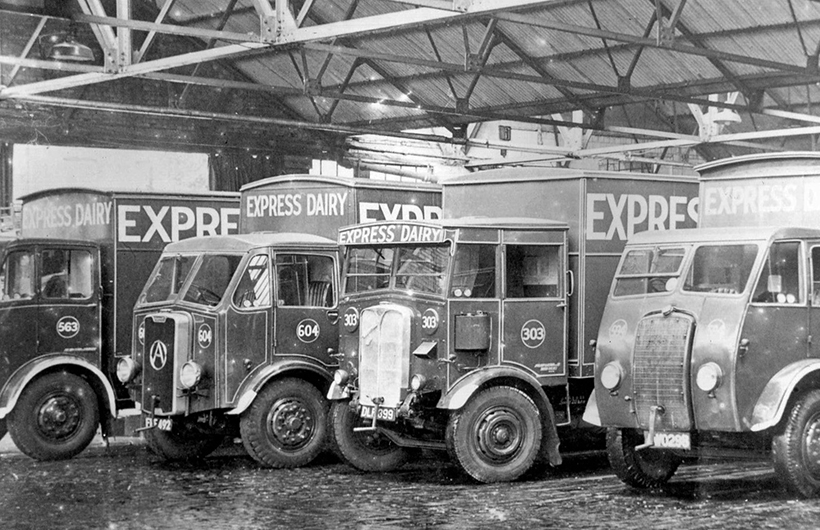
Taken at the same time as the Foden/AEC/ERF trio above, this shows another mixture of box vans lined up at Cricklewood. The attractive TSC18 Leyland Beaver on the left, was one of a number of these purchased in 1942. A second, petrol-engined Mammoth Major, fleet no 303, supplied in December 1936 is seen on the right, and wears diminutive wartime headlights. The Atkinson in the centre, however, has a large set, and was another second-hand purchase from Murphy Bros of Leicester. New on January 1st, 1938, chassis no FC514 was fitted with a Gardner 5LW no 40725, fleet no 604, FRF 492. It was purchased in August 1943 for £2,750, and sold to Birds of Stratford on 28/1/47, for £1,175.

This is something of a rarity, an AEC Mammoth Minor, chassis no 03662084, with engine no A173/1799. It was first registered in Leicester on 1/11/39, and purchased from Murphy Bros in the town in July 1944, for £3,500. This model was only listed between 1936 and 1940. In 1945, the box van body shown was built and fitted, and the cab repaired at cost of £389, followed by a mechanical overhaul at £609. In February 1947, it passed to Birds of Stratford, for £650 (Courtesy BCVM).
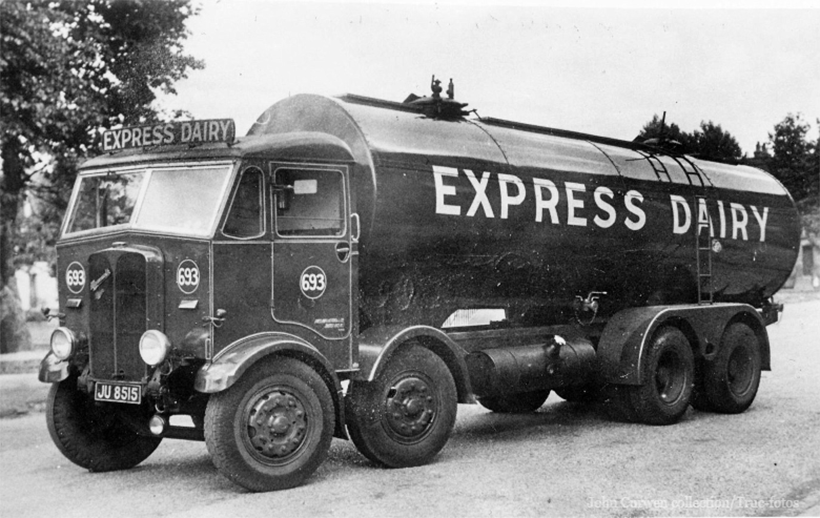
The updated ‘386’ series Mammoth Major was introduced to the market in 1936, and this oil-engined example, on chassis no 0386082, was registered JU 8515 in Leicester in April of that year. Again, Murphy Bros of Leicester were the agents who sold it to the dairy in August 1944, for £3,100. In May 1946, a new cab was fitted, complete with mudguards, at a total cost of £252. It was sold in October 1948 to the London Brick Co for £600, plus £23 16s 8d purchase tax. The tank was removed for refurbishment and fitting to a new Mammoth Major, fleet no 961.
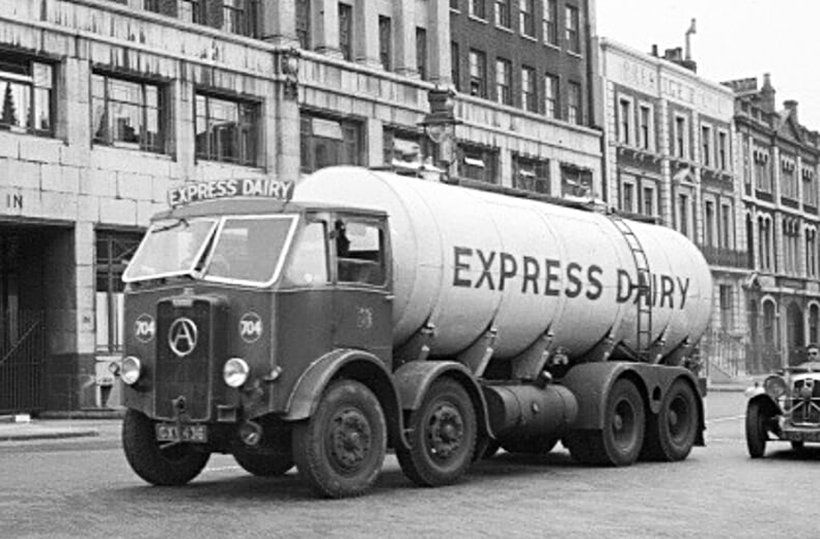
Seen in Grosvenor Road, London, in 1950, and photographed by Arthur Hustwitt, this Atkinson Model L1586, chassis no FC1084 was a one-off wartime allocation in 1945, supplied through Godfrey Davis of Neasdon, NW10, but not registered GXY 436 until March 1946. It was sold for £700 in 1952, but the tank was transferred to a new AEC Mammoth Major, fleet no 1333, seen in a later image. (NA3T)
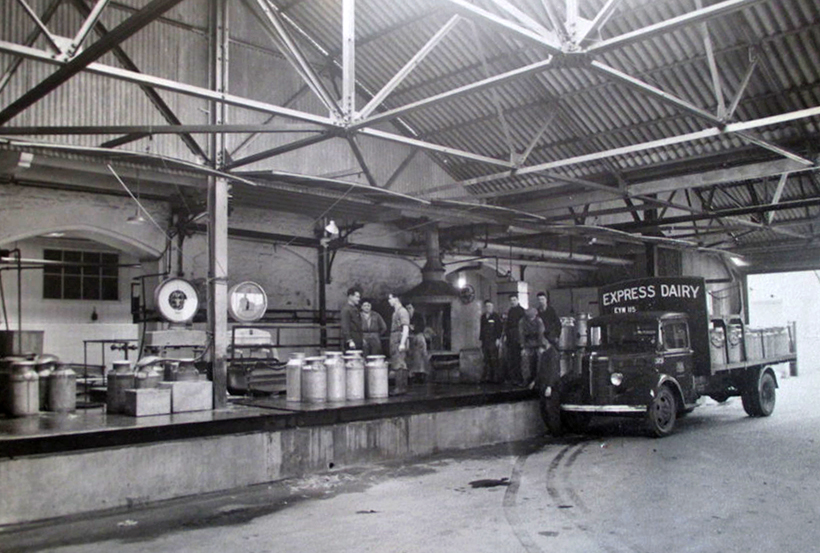
Seen on the loading bank at the Seaton Junction Dairy in East Devon, with the typical Avery scales to hand, this example of the updated Bedford ‘WTL’, fleet no 373, EYW 115, was purchased from Spurlings in August 1938, and carried a classic chain-sided churn body. Now looking rather tired and still missing the offside headlight (no doubt a wartime removal) it gave 11 hard year’s graft, before sale to T&F Motors of Finchley in November 1949, for £35 plus purchase tax (7¾%) of £2 14s 2d.

This wonderful piece of artwork is taken from a lavish catalogue produced by WP Butterfield Ltd, of Shipley and, although the Mammoth Major illustrated was delivered in September 1947, other vehicles depicted dated from six years later. Fleet no 928, JXN 492, on chassis no 0386846, was supplied at a cost of £2,346, the Duramin cab came to £211 and the 3,000-gallon tank, £1,210. Thanks to a very helpful clerk with his fountain pen, we know that the vehicle entered service on the 12/4/48, at the dairy in Leyburn in the Yorkshire Dales. This first opened in 1937, with the milk sent by direct rail link for bottling at Cricklewood. The chassis-cab was sold to Hamptons of Fenstanton in February 1957, for £1,200.
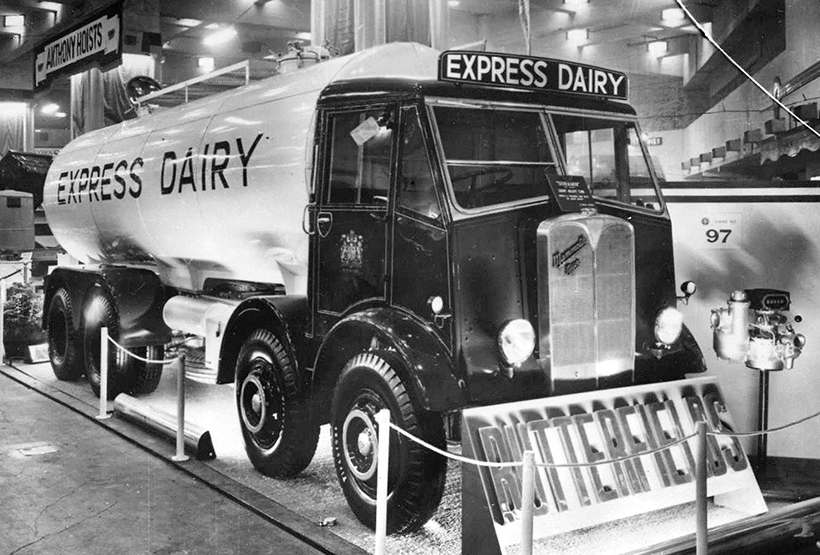
A similar Mammoth Major tanker seen on Butterfield’s stand no 97, at the first, post-war Commercial Motor Show at Earls Court, in October 1948.

Posed at Southall when new, with the railway bridge to the left, Mammoth Major, chassis no 3871H349, engine no A216-25, was purchased in December 1949 and allocated fleet no 1093, LLX 260. Again fitted with a Duramin cab and fittings costing £304, chassis £2,620 and the Thompson Bros of Bilston stainless steel 3,000-gallon tank at £1,270. This one was displayed at the 1950 Commercial Show, with the ‘Special Show’ paintwork adding another £700 to the initial cost! The chassis passed to Birds in May 1963 for £100, but the tank was transferred twice for a further lease of life to later chassis.
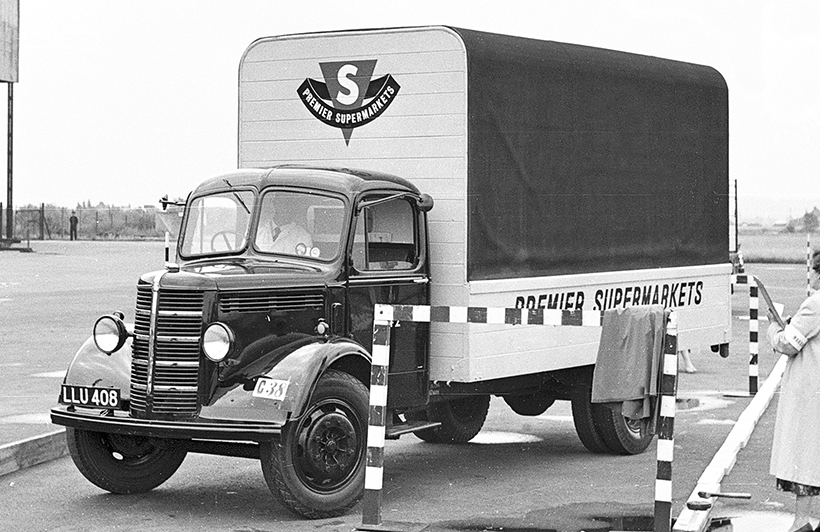
Seen at one of the many Lorry Driver of the Year competitions, this small Bedford supplied fruit and veg to the early Premier supermarkets, from their inception in 1955. Fleet no 1142 was new in June 1950, on chassis no OLAC142505, and was supplied by SMT Sales of Church Street, Carlisle, for £500, with the produce body adding a further £180. Disposal came in January 1959 to Hamptons, Fenstanton, for £110.
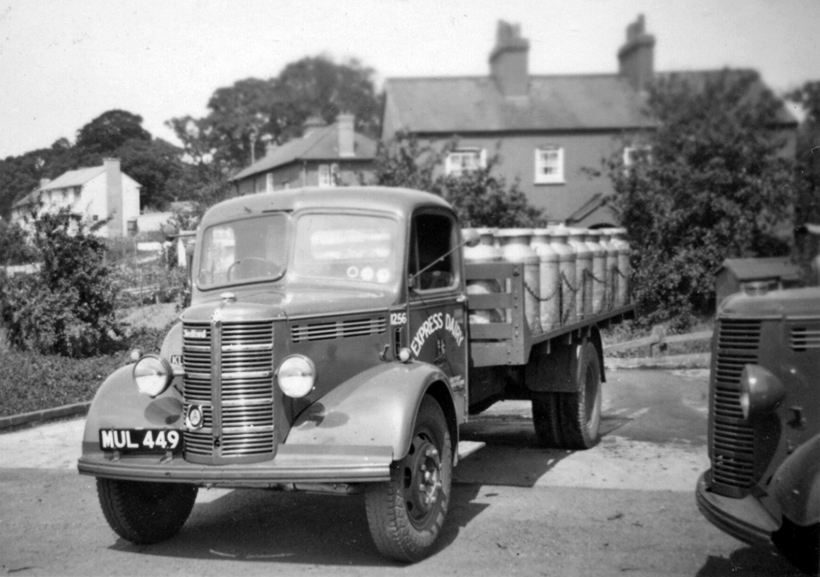
A typical example of a chain-sided churn lorry, finished in ‘shop grey’. This Bedford, on chassis no OLAC216296, with engine no 216167, fleet no 1256, MUL 449, was supplied by SMT Sales of Carlisle, but was then allocated to Seaton Junction. Disposal to T&F Motors came in March 1959, when it fetched £110.

The milk must get through! This Mammoth Major, chassis no 3871H1021, engine no A216 J1295, was new in January 1952. The tank, however, was formerly carried on a wartime Atkinson, fleet no 704, GXY 436. Again fitted with a Duramin cab, the specification included five-speed gearbox, 6.4:1 axle ratio and air brakes. The chassis later passed to Hamptons of Fenstanton, but the tank went on for a third life.
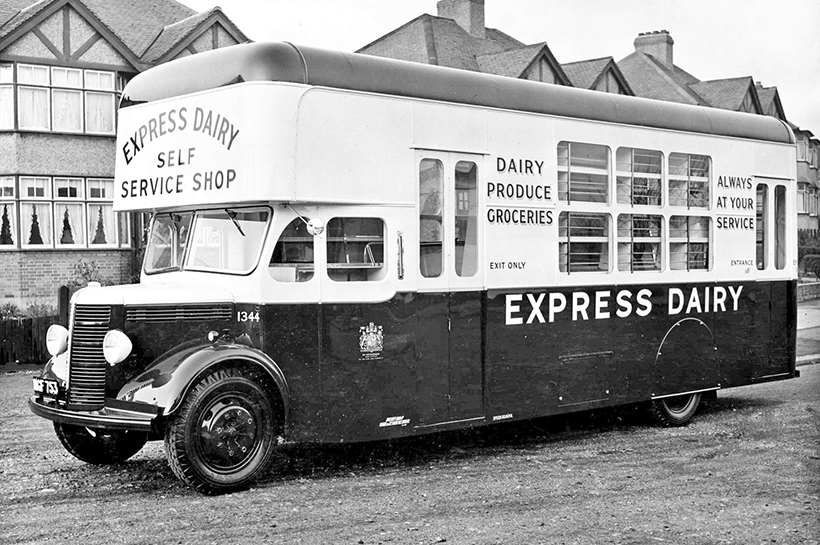
The ‘semi-detached’ setting is appropriate for this mobile grocery shop dating from 1952, on Bedford chassis no 0LAC241245, engine no 241716, which was supplied by Capital Motors of London, N1. The body was built by Spurlings, for an on-the-road price of £2,469. Various modifications and additions in the early days of service included partitions counters, coat hooks, shelves and a bacon bench. It only enjoyed a five-year service life, before sale to King & Taylor of Godalming in September 1957, for £850. One wonders where it went next?
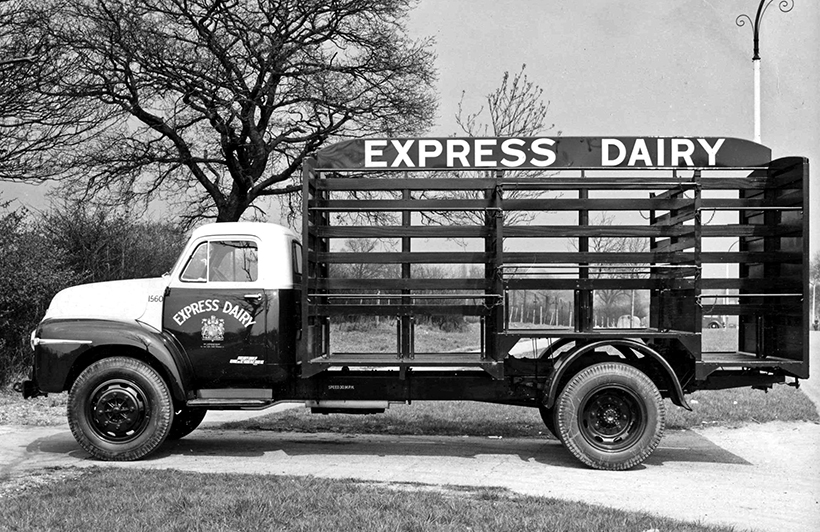
Seen when new, this attractive Bedford ‘A’ Series, chassis no A5LCG28490, engine no A4/A525797, was registered on March 8th, 1954, as OXT 252. Just 17 days later, it received a diesel transplant at an additional cost of £310. Sold in October 1961 to T&F Motors, it raised just £58.

Another chassis purchased in September 1954, was this Commer 25cwt, chassis no 52A0952, engine no 3114. Fleet no 1692, PUC 198, was supplied through Rootes of St Johns Wood Road, with bodywork built by Strachans of Acton. Passing to Hamptons at Fenstanton in 1962, it made just £50.
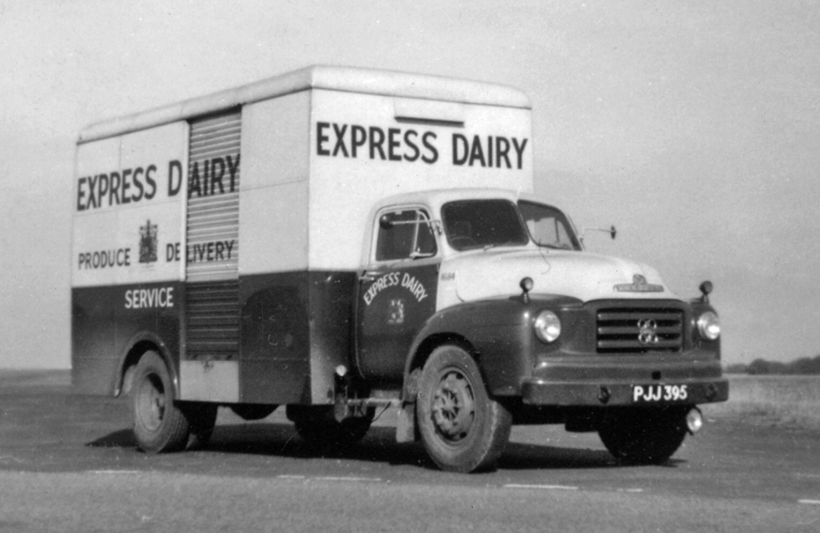
Supplied by Kingston Hill Motors in August 1954, this Perkins-engined Bedford ‘A’ Series, on chassis no A5LCG37045, engine no 33238, PJJ 395, was allocated fleet no 1684. Strachans again built the body. In June 1962, it passed to T&F Motors, for £110.
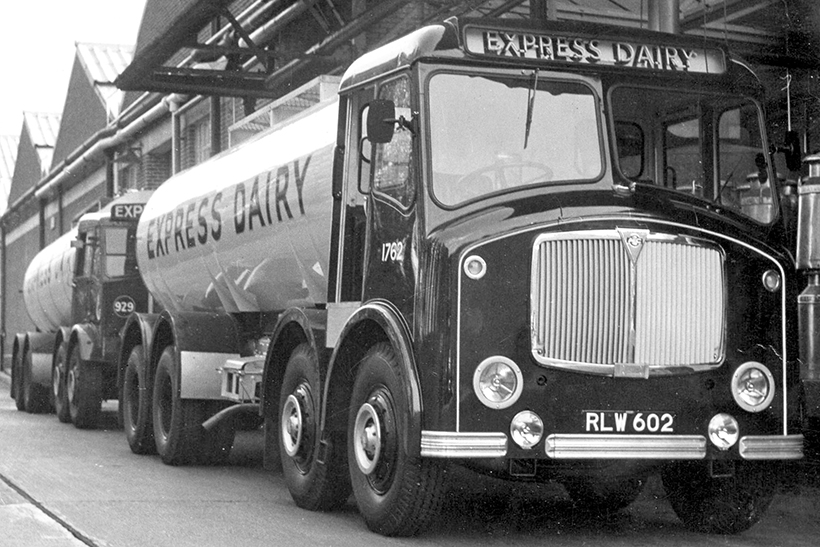
Two generations of Mammoth Major Mk III stand in line. The new ‘tin front’, with distinctive Strachan cab, chassis no 3871H1856, engine no A216JX2783, fleet no 1762, RLW 602, was new in January 1955. The tank was another Butterfield product. The chassis passed to T&F Motors in December 1964, for £150. Behind stands chassis no 0386845, engine no 299, fleet no 929, JXN 505, new in September 1947. It entered service with the tanker pool on 1/2/48 and passed to Birds in 1957, for £1,000.
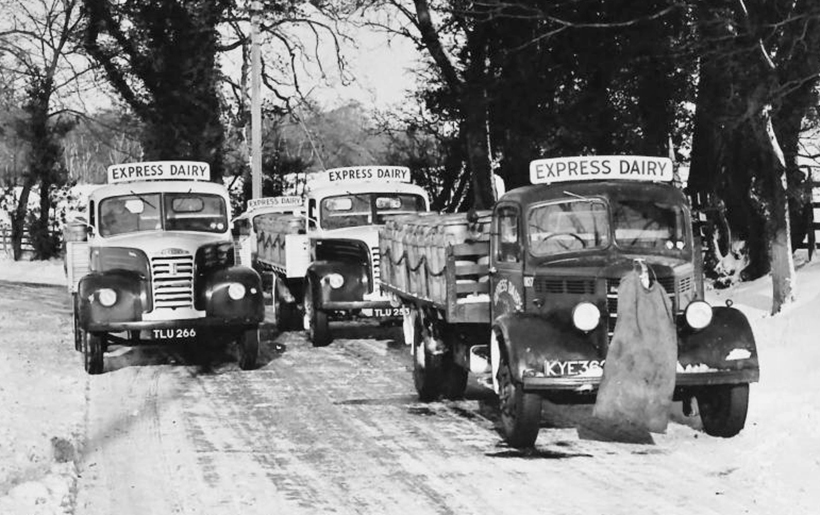
Seen during the winter of 1957-‘58 in the Dales, in company with some 1957 Fordson ‘Costcutters’, in very wintry conditions, this Bedford, chassis no OLAC13209, fleet no 1107, KYE 362, was again supplied by Spurlings, with the body costing £120. It was allocated new to the Leyburn Dairy in March 1950, and was disposed of in May 1958 to T&F Motors, for £50.
To subscribe to Vintage Roadscene magazine, simply click here



